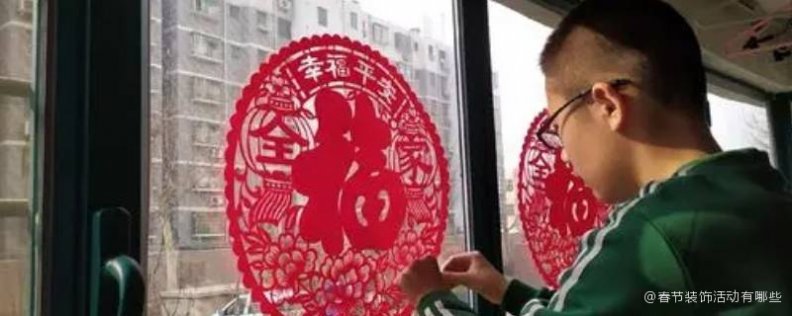春节传统装饰活动有哪些,请问春节装饰活动有
春节传统装饰活动有哪些,请问春节装饰活动有哪些?
据和记百科网站「耐不住得寂寞」消息,近日,春节传统装饰活动有哪些,请问春节装饰活动有哪些?引发热议,春节传统装饰活动有哪些同样引起许多争议,对此众网友各抒己见。但到底是怎么回事呢?和记百科为您解答。
春节装饰活动有哪些

1、贴窗花:新春佳节时,许多地区的人们喜欢在窗户上贴上各种剪纸——窗花。窗花不仅烘托了喜庆的节日气氛,而且也为人们带来了美的享受,集装饰性、欣赏性和实用性于一体。
2、贴“福”字:春节贴“福”字,无论是现在还是过去,都寄托了人们对幸福生活的向往,也是对美好未来的祝愿。每逢新春佳节,家家户户都要在屋门上、墙壁上、门楣上贴上大大小小的"福"字。春节贴“福”字,是民间由来已久的风俗。
3、贴吊钱:贴吊钱的历史由来已久,因名称中带有“钱”字,把它们挂在门前檐下,预示着新的一年中财源会滚滚而来。一般认为贴吊钱是始于宋朝的一种习俗,其实早在晋代就有贴吊钱儿的习俗了。中国古代有以幡胜表达意愿的风俗,这在《后汉书·礼仪志》中已有记载。
4、贴门神:门神,即司门守卫之神,是农历新年贴于门上的一种画类。 作为民间信仰的守卫门户的神灵,人们将其神像贴于门上,用以驱邪避鬼、卫家宅、保平安、助功利、降吉祥等,是中国民间深受人们欢迎的守护神。
5、贴年画:春节挂贴年画在城乡也很普遍,浓黑重彩的年画给千家万户平添了许多兴旺欢乐的喜庆气氛。年画是中国的一种古老的民间艺术,反映了人民朴素的风俗和信仰,寄托着他们对未来的希望。随着木板印刷术的兴起,年画的内容已不仅限于门神之类单调的主题,变得丰富多彩。
春节传统装饰活动有哪些
为您提供以下8种观点,仅供参考。
1、贴窗花(26%)。在春节里面都是需要贴窗花的,当然南北方是有一定的区别的,一般北方城市在春节里面都会选择贴窗花的,在贴窗花的时候一般都是需要贴在窗户的里面。
2、春节挂灯笼(26%)。春节挂灯笼 春节挂象征团圆意义的红灯笼,来营造一种喜庆的氛围。后来灯笼就成了中国人喜庆的象征。中国的春节灯笼又统称为灯彩。起源于1800多年前的西汉时期,每年的农历正月十五元宵节前后,人们都挂起象征团圆意义的春节灯笼,来营造一种喜庆的氛围。
3、贴春联(26%)。贴春联 春联也叫门对、春贴、对联、对子、桃符等,它以工整、对偶、简洁、精巧的文字描绘时代背景,抒发美好愿望,是我国特有的文学形式。每逢春节,无论城市还是农村,家家户户都要精选一幅大红春联贴于门上,为节日增加喜庆气氛。
4、贴福字(14%)。 过春节的时候大家都会将家里打扫一下,工程量还是比较大的,打扫完毕之后就可以粘贴春联,贴福字,这些都是传统的活动。如果想要增加节日的气氛,也有不少家庭会在家里挂上灯笼,挂上彩灯等等,装饰效果还是比较好的,我们可以根据个人的需求来选择产品,而且这些产品...
5、剪纸(3%)。 春节里传统装饰活动有很多的,包括贴对联,贴窗花,剪纸,贴福字,挂灯笼等等,这些都是比较传统的,基本上每家每户都会这么操作。
6、中国结(2%)。中国结 中国结寓意着团结、幸福、平安,是一种中国特有的手工编织工艺品,它原本是由旧石器时代的缝衣打结,后推展至汉朝的仪礼记事,再演变成今日的装饰手艺。 中国结造型优美、色彩多样,是赞颂以及传达衷心至诚的祈求和心愿的最佳媒介,用一根绳线将暖暖的心意融入...
7、生肖摆件(2%)。生肖摆件 十二生肖是十二地支的形象化代表,是历史悠久的民俗文化符号,每一种生肖都有丰富的传说,随着历史的发展形成一种观念阐释系统,成为民间文化中的形象哲学。 现代更多人会将生肖作为春节的吉祥物,生肖玩偶、生肖贴纸,成为新春装饰的主角,营造喜庆祥瑞的新...
8、走亲戚串串门儿(1%)。另外,在春节期间其实也是有很多活动的,你比如说我们可以走亲戚串串门儿,也可以几个朋友聚在一起守年。
【英文介绍/For English】:
1. Paste window decorations: During the Spring Festival, people in many areas like to paste various paper-cuts on the windows - window decorations. The window grilles not only set off the festive atmosphere, but also bring people the enjoyment of beauty, integrating decoration, appreciation and practicality.
2. Paste the word "Fu": The word "Fu" is posted in the Spring Festival, whether it is now or in the past, it expresses peoples yearning for a happy life, and it is also a wish for a better future. Every Chinese New Year festival, every household should put the characters "Fu" big and small on the door, wall and lintel of the house. It is a long-standing folk custom to paste the word "Fu" during the Spring Festival.
3. Hanging money: The history of hanging money has a long history. Because of the word "money" in the name, hanging them under the eaves in front of the door indicates that the money will come rolling in in the new year. It is generally believed that sticking hanging money is a custom that began in the Song Dynasty. In fact, there was a custom of sticking hanging money as early as the Jin Dynasty. In ancient China, there was the custom of expressing wishes with flags, which has been recorded in the Book of the Later Han Dynasty.
4. The door god: The door god, the god of the door guard, is a kind of painting that is pasted on the door during the Chinese New Year. As the gods guarding the door in folk beliefs, people stick their statues on the door to exorcise evil spirits, protect the house, keep peace, help utilitarianism, and bring good luck. It is a popular guardian deity among Chinese people.
5. Sticking New Year pictures: The New Year pictures are also common in urban and rural areas during the Spring Festival. New Year pictures are an ancient folk art in China, reflecting the simple customs and beliefs of the people and pinning their hopes for the future. With the rise of woodblock printing, the content of New Year pictures is not limited to monotonous themes such as door gods, but has become colorful.
【相关文章】
★ 种植花椒的条件






